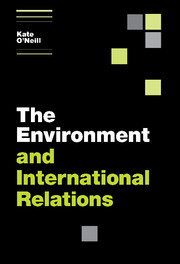Book contents
- Frontmatter
- Contents
- Preface
- Acknowledgements
- List of commonly used abbreviations
- 1 Introduction: The environment and international relations
- 2 International environmental problems
- 3 Actors in international environmental politics
- 4 State-led global environmental governance: International cooperation and regime formation
- 5 The impacts and effectiveness of environmental treaty regimes
- 6 Global economic governance and the environment
- 7 Non-state global environmental governance
- 8 Conclusions: The environment and international relations in the twenty-first century
- References
- Index
- References
2 - International environmental problems
Published online by Cambridge University Press: 05 June 2012
- Frontmatter
- Contents
- Preface
- Acknowledgements
- List of commonly used abbreviations
- 1 Introduction: The environment and international relations
- 2 International environmental problems
- 3 Actors in international environmental politics
- 4 State-led global environmental governance: International cooperation and regime formation
- 5 The impacts and effectiveness of environmental treaty regimes
- 6 Global economic governance and the environment
- 7 Non-state global environmental governance
- 8 Conclusions: The environment and international relations in the twenty-first century
- References
- Index
- References
Summary
As with many other issues – managing the global economy, human rights, combating diseases such as HIV/AIDS, and controlling terrorism and the proliferation and global spread of weapons of mass destruction – the global environment represents a series of problems that are so complex and widespread that unilateral measures – measures undertaken by countries acting on their own initiative – are not enough to forestall them. This is an interdependent world: even if a country the size of the USA or Brazil managed to reduce its greenhouse gas emissions by a significant amount, without other countries doing likewise, we cannot prevent the total impacts of climate change.
Global problems are not new. But, over recent decades, they have increased in scale, scope, visibility, and complexity. The international community itself has changed too. Membership of the United Nations has grown by 370 percent since 1945; NGOs, corporations, and expert groups are seeking a voice in international affairs; economic globalization has increased the complexity of global management; and new technology – notably the internet – has vastly increased the speed and quantity of information traveling the globe (Simmons and Oudraat 2001).
This chapter does not set out to provide an assessment of the state of the global environment in the early years of the twenty-first century and the directions in which it is headed.
- Type
- Chapter
- Information
- The Environment and International Relations , pp. 24 - 47Publisher: Cambridge University PressPrint publication year: 2009



